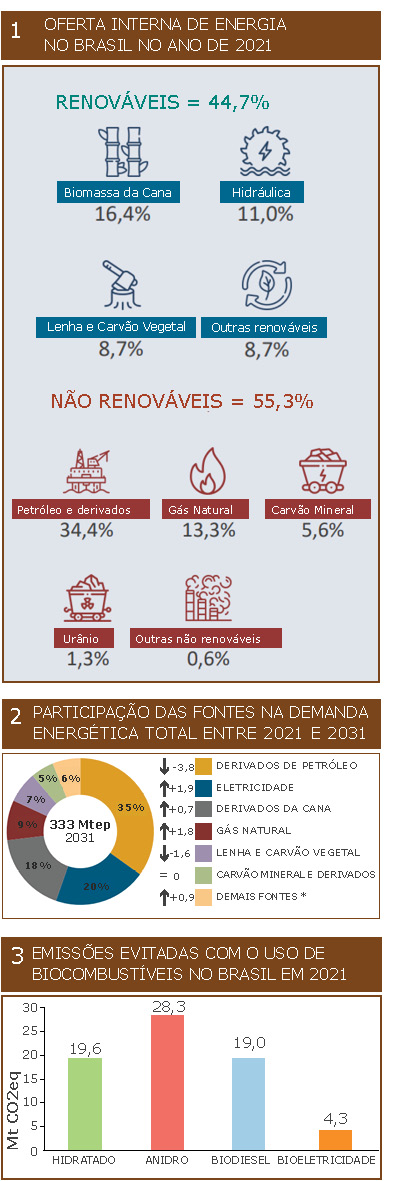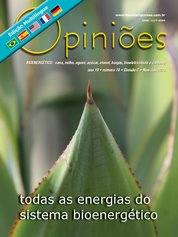Heloisa Borges Bastos Esteves
Diretora de Estudos do Petróleo, Gás Natural e Biocombustíveis da EPE - Empresa de Pesquisa Energética
OpAA74
Bioenergia: a fortaleza da estratégia energética
O Brasil é um país reconhecidamente dotado de características edafoclimáticas (condições de solo e clima), que permitem diversas fontes de biomassa prosperarem de forma abrangente. Como entoa uma música popular no Brasil, moramos em um país tropical, abençoado por Deus e bonito por natureza. Diante de tão profícua oferta, o Brasil ocupa posição de destaque no mundo quanto à biotecnologia e à bioenergia, e esta última não poderia deixar de ser uma das fortalezas da estratégia brasileira rumo a um futuro energético sustentável.
A utilização da biomassa na indústria energética ocorre através de rotas tecnológicas diversas no País: tradicionalmente, aproveitamos, de forma direta, a lenha, o bagaço da cana-de-açúcar, a lixívia, resíduo do setor de papel e celulose, e cascas de arroz, através da combustão; e, através da transformação em biocombustíveis, os açúcares da cana dão origem ao etanol, e os óleos de culturas oleaginosas, como a soja e o algodão, e os sebos ou gorduras animais são insumos para o biodiesel e diesel renovável.
 Mas, além das mais conhecidas, há diversas biomassas alternativas disponíveis para o aproveitamento energético no País, como resíduos da cana-de-açúcar (palhas e pontas, vinhaça e torta de filtro), resíduos da indústria madeireira (cavaco), palhas das culturas de soja e milho, cascas de arroz e café, resíduos de coco, feijão, amendoim, mandioca e cacau, resíduos agroindustriais e pecuários de confinamento, lodo de estação de tratamento de esgoto e resíduos sólidos urbanos (RSU), entre outros, que podem ser utilizadas para combustão direta ou produção de biocombustíveis.
Mas, além das mais conhecidas, há diversas biomassas alternativas disponíveis para o aproveitamento energético no País, como resíduos da cana-de-açúcar (palhas e pontas, vinhaça e torta de filtro), resíduos da indústria madeireira (cavaco), palhas das culturas de soja e milho, cascas de arroz e café, resíduos de coco, feijão, amendoim, mandioca e cacau, resíduos agroindustriais e pecuários de confinamento, lodo de estação de tratamento de esgoto e resíduos sólidos urbanos (RSU), entre outros, que podem ser utilizadas para combustão direta ou produção de biocombustíveis.
 Mas, além das mais conhecidas, há diversas biomassas alternativas disponíveis para o aproveitamento energético no País, como resíduos da cana-de-açúcar (palhas e pontas, vinhaça e torta de filtro), resíduos da indústria madeireira (cavaco), palhas das culturas de soja e milho, cascas de arroz e café, resíduos de coco, feijão, amendoim, mandioca e cacau, resíduos agroindustriais e pecuários de confinamento, lodo de estação de tratamento de esgoto e resíduos sólidos urbanos (RSU), entre outros, que podem ser utilizadas para combustão direta ou produção de biocombustíveis.
Mas, além das mais conhecidas, há diversas biomassas alternativas disponíveis para o aproveitamento energético no País, como resíduos da cana-de-açúcar (palhas e pontas, vinhaça e torta de filtro), resíduos da indústria madeireira (cavaco), palhas das culturas de soja e milho, cascas de arroz e café, resíduos de coco, feijão, amendoim, mandioca e cacau, resíduos agroindustriais e pecuários de confinamento, lodo de estação de tratamento de esgoto e resíduos sólidos urbanos (RSU), entre outros, que podem ser utilizadas para combustão direta ou produção de biocombustíveis.Na repartição da oferta interna de energia do Brasil em 2021, a biomassa da cana respondeu por 16,4% da nossa matriz energética, com outras renováveis (incluindo a lixívia e o biodiesel) respondendo por 8,7% adicionais. Essa bioenergia move o País e atende principalmente ao setor de transportes e ao setor elétrico: enquanto, no setor elétrico, a participação da biomassa atingiu 8,2% em 2021, no setor de transportes, alcançou 22,6% no mesmo ano.
A participação da bioenergia no transporte remonta à década de 1930. Entretanto, ganhou espaço na nossa matriz energética na década de 1970, com a mistura obrigatória de etanol anidro à gasolina e aos incentivos diretos e indiretos para esse biocombustível. No início do século XXI, foram lançados o Programa Nacional de Produção e Uso de Biodiesel (PNPB) e, mais recentemente, a Política Nacional de Biocombustíveis (RenovaBio) e o Programa Combustível do Futuro. Todos são políticas públicas destinadas ao estímulo de combustíveis de origem renovável no Brasil, que garantem que, tanto no médio quanto no longo prazos, os biocombustíveis não apenas mantenham participação relevante na matriz energética brasileira, mas, de fato, ampliem, cada vez mais, sua presença já no cenário decenal.
Da mesma forma, no setor elétrico, o aproveitamento da biomassa não é recente. De fato, o aproveitamento da energia do bagaço da cana-de-açúcar coincide com a implantação das primeiras usinas no território brasileiro. Esse insumo residual destinava-se, entretanto, inicialmente, ao autoconsumo, sendo os incentivos às fontes renováveis na geração de energia elétrica mais recentes do que no setor de transporte. Um importante marco para a intensificação do uso da bioenergia na geração de eletricidade é o Proinfa (Programa de Incentivo às Fontes Alternativas de Energia Elétrica), programa criado por Lei, com o objetivo de aumentar a participação de fontes alternativas renováveis (PCH, eólicas e biomassas) na produção de energia elétrica.
Ao longo dos últimos anos, a bioeletricidade tem mantido participação relevante na matriz elétrica nacional. A energia total contratada no mercado regulado (ACR) atingirá aproximadamente 1 GW médio ao fim de 2025, com destaque para o setor sucroenergético, que vem aumentando sua contribuição na matriz elétrica com a bioeletricidade. Até o final da década, espera-se uma expansão do período de geração de bioeletricidade, incorporando palhas e pontas e, em alguns casos, biomassas diferentes da cana. Estima-se que a projeção baseada no histórico atinja 4,1 GW médios, e o potencial técnico para comercialização, a partir da biomassa, seja de 6 GW médios até o final da década. Cabe destacar que, embora os derivados da cana tenham figurado como grandes protagonistas dentre as biomassas na geração elétrica, o uso de outras fontes, como o licor negro, tem mostrado aumento de sua participação nos últimos anos.
Outra fonte com grande potencial de participação na matriz energética nacional é o biogás. As projeções da Empresa de Pesquisa Energética indicam que o biogás do setor sucroenergético terá uma maior inserção na matriz energética, podendo ser destinado não apenas à geração elétrica, mas na substituição ao diesel e misturado ao gás natural fóssil, nas malhas de gasodutos. Estima-se que o potencial de produção, até o final da década, seja de 7,1 bilhão de Nm³ oriundos da vinhaça e da torta de filtro e de 5,7 bilhões de Nm³ advindos das palhas e pontas da cana-de-açúcar.
Considerando o surgimento de novas tecnologias com elevada eficiência e menores impactos ambientais em seu uso, inclusive cooperando para a mitigação do aquecimento global, a bioenergia ganha cada vez maior espaço como uma das opções mais promissoras para o futuro energético sustentável. E esse efeito já é notado hoje: a elevada participação de renováveis na matriz energética nacional proporciona uma significativa redução nas emissões de GEE.
As emissões evitadas pelo uso de etanol (anidro e hidratado) e biodiesel no setor de transporte somaram 66,9 MtCO2 em 2021. Já na matriz elétrica brasileira, que apresenta uma das menores intensidade de carbono do mundo, a bioeletricidade de cana-de-açúcar contribuiu com a mitigação de 4,3 MtCO2.
A bioenergia tem o potencial de mudar o mundo, contribuindo, de forma decisiva, para a transição energética. Em escala global, além de ser uma das alternativas mais viáveis para substituir o uso de combustíveis fósseis, os diferentes tipos de bioenergia são vistos como uma forma de aumentar a captura de carbono na produção dos hidrocarbonetos. E essa já é uma realidade e uma vantagem para o Brasil.




